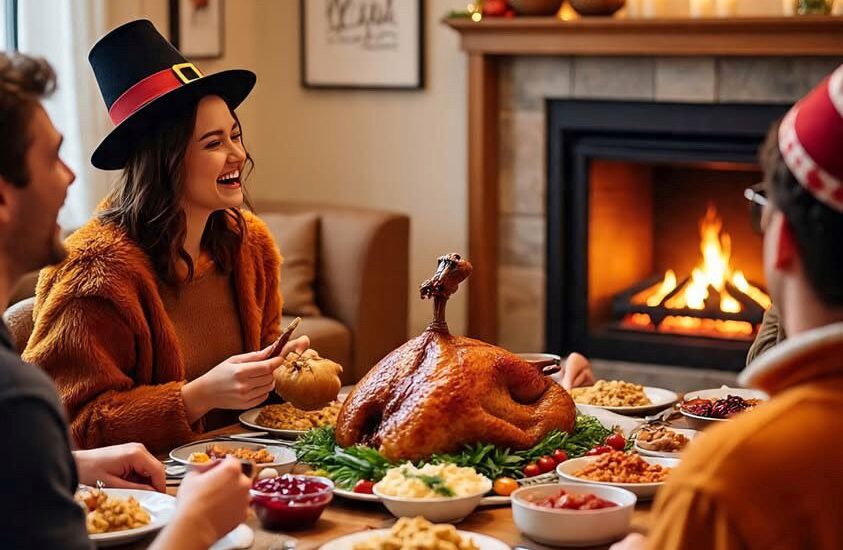Every year when November rolls around, I find myself scrolling through social media and seeing the same jokes pop up. You know the ones. Turkey pardons that go hilariously wrong, pilgrim memes that probably would make our ancestors cringe, and those inevitable Black Friday satires that feel more real than we would like to admit. Thanksgiving humor has become as traditional as the cranberry sauce nobody really wants but everyone puts on their plate anyway. Discover why turkey jokes and holiday parodies never go out of style.
The tradition of poking fun at Thanksgiving actually goes back further than most people realize. I remember my grandmother telling me about radio shows in the 1930s and 1940s that would do comedy sketches about disastrous holiday dinners. These were not the polished productions we see on streaming services today. They were raw, sometimes awkward, and absolutely hilarious because they captured something real about the American experience. Families gathering together, tensions rising over politics and burnt turkey, and somehow still managing to call it a celebration.
When television became the dominant form of entertainment, Thanksgiving parodies found their perfect medium. The 1960s and 1970s gave us variety shows that would dedicate entire episodes to holiday humor. Carol Burnett did sketches about family dysfunction that still hold up today. Johnny Carson made turkey jokes a staple of his Tonight Show monologues every November. What made these jokes work was not that they were particularly sophisticated. They worked because everyone could relate to the chaos of preparing a massive meal while trying to keep family members from arguing about religion or politics at the dinner table.

The interesting thing about Thanksgiving comedy is how it evolved alongside our cultural understanding of the holiday itself. Early parodies were pretty gentle, focusing mostly on cooking disasters and family quirks. My father used to tell me about Mad Magazine spreads in the 1950s that would show exaggerated dinner scenes with teenagers sneaking away and grandparents falling asleep in their mashed potatoes. Innocent stuff, really. But as America became more willing to examine its own history critically, Thanksgiving humor started incorporating more complex themes.
By the 1990s, you could not turn on a sitcom without finding at least one Thanksgiving episode that questioned the traditional narrative we had been taught in elementary school. Shows like Friends gave us the infamous turkey head scene, while Seinfeld deconstructed every aspect of the holiday with its characteristic cynicism. Saturday Night Live began producing sketches that were not just about family drama but about the disconnect between what we say Thanksgiving represents and what it actually meant historically. Some of these sketches walked a fine line between comedy and social commentary, which is exactly what good parody should do.
The internet changed everything, though. I still remember the first Thanksgiving memes I saw back in the early 2000s. They were crude by today’s standards, mostly just text overlaid on stock photos of turkeys or pilgrims. But they spread like wildfire because suddenly anyone with an internet connection could participate in the tradition of Thanksgiving humor. You did not need to be a professional comedian or get a spot on a television show. You just needed a funny observation and maybe some basic Photoshop skills.
What fascinates me most about modern Thanksgiving parodies is how they have become more specific and more universal at the same time. There are jokes that speak directly to particular communities and their unique experiences with the holiday. At the same time, certain themes have become so widespread that they transcend cultural boundaries. Everyone understands the humor in dealing with that one relative who makes everything awkward, or the panic of realizing at the last minute that you forgot to buy an essential ingredient.
Social media platforms have turned Thanksgiving comedy into an annual competition. Twitter threads about cooking failures go viral every year. Instagram stories filled with sarcastic commentary on family gatherings get shared thousands of times. TikTok has given rise to elaborate parody videos that reimagine the first Thanksgiving with modern technology or contemporary slang. Some of these are genuinely creative pieces of content that probably took hours to produce.
I wonder sometimes if we use humor as a way to deal with the inherent contradictions of Thanksgiving. We are supposed to be grateful and reflective, but we are also stressed about cooking and hosting. We celebrate togetherness while dreading certain conversations. We acknowledge problematic aspects of the holiday’s origins while still wanting to enjoy time with family. Parodies and jokes give us permission to acknowledge all of these tensions without ruining the day entirely.
Looking back at decades of Thanksgiving humor, what strikes me is how the format changes but the core themes remain remarkably consistent. Whether it was a radio sketch from 1945 or a viral tweet from last year, the jokes still revolve around food, family, and the gap between expectation and reality. Maybe that consistency is what makes Thanksgiving parodies so enduring. They remind us that generations before us dealt with the same holiday chaos we face today, and somehow that makes the whole experience feel more manageable. Plus, laughing about it sure beats crying into your pumpkin pie.
Reference
National Museum of the American Indian. (2018). Thanksgiving: A new look at a national myth. Smithsonian Institution.
Pleck, E. H. (2000). Celebrating the family: Ethnicity, consumer culture, and family rituals. Harvard University Press.
Martin, R. A. (2007). The psychology of humor: An integrative approach. Academic Press.

